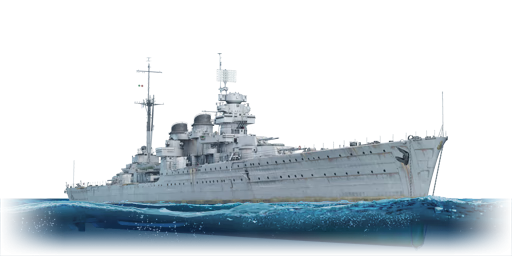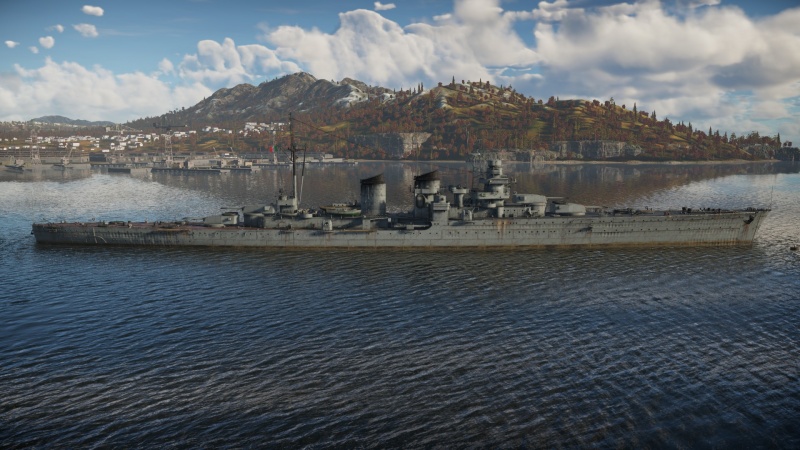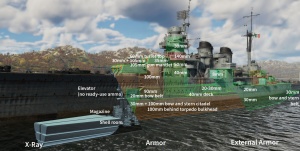RN Duca degli Abruzzi
Contents
Description
Luigi di Savoia Duca degli Abruzzi was the first ship of the Duca degli Abruzzi-subclass of Condottieri cruisers, commissioned 1 December 1937. During World War 2, she saw naval combat only once, in the Battle of Punta Stilo, where she engaged British 7th Cruiser Squadron without scoring any hits. In November 1941, she had her stern blown off by a torpedo from a British aircraft based on Malta, which was later repaired. After the Armistice, she surrendered at Malta and served as an anti-blockade-runner, patrolling the central Atlantic from Freetown in Sierra Leone. After the end of World War 2, she underwent three refits - in 1947, 1951-53, and 1955 - serving in the Italian navy until 1961.
The most advanced of the Italian Condottieri-class cruisers, RN Duca degli Abruzzi was introduced in Update "Apex Predators". She's in a higher BR than the previous vessels of the class, making her fight against much more challenging opponents, as a result she struggles to deal with opponents due to a small explosive filler, low rate of fire, and insufficient armour to deal with enemy vessels. She's best used to support friendlies with torpedoes and picking off the weakest targets in the enemy team to avoid attention from the most challenging opponents.
General info
Survivability and armour
Talk about the vehicle's armour. Note the most well-defended and most vulnerable zones, e.g. the ammo magazine. Evaluate the composition of components and assemblies responsible for movement and manoeuvrability. Evaluate the survivability of the primary and secondary armaments separately. Don't forget to mention the size of the crew, which plays an important role in fleet mechanics. Save tips on preserving survivability for the "Usage in battles" section. If necessary, use a graphical template to show the most well-protected or most vulnerable points in the armour.
Mobility
Write about the ship's mobility. Evaluate its power and manoeuvrability, rudder rerouting speed, stopping speed at full tilt, with its maximum forward and reverse speed.
| Mobility Characteristics | |||
|---|---|---|---|
| Game Mode | Upgrade Status | Maximum Speed (km/h) | |
| Forward | Reverse | ||
| AB | |||
| Upgraded | 75 | 34 | |
| RB/SB | |||
| Upgraded | 64 | 29 | |
Modifications and economy
Armament
Primary armament
Provide information about the characteristics of the primary armament. Evaluate their efficacy in battle based on their reload speed, ballistics and the capacity of their shells. Add a link to the main article about the weapon: {{main|Weapon name (calibre)}}. Broadly describe the ammunition available for the primary armament, and provide recommendations on how to use it and which ammunition to choose.
| Penetration statistics | |||||||
|---|---|---|---|---|---|---|---|
| Ammunition | Type of warhead |
Penetration @ 0° Angle of Attack (mm) | |||||
| 1,000 m | 2,500 m | 5,000 m | 7,500 m | 10,000 m | 15,000 m | ||
| HE Dirompente | HE | 29 | 29 | 29 | 29 | 29 | 29 |
| APHEBC Palla | APHEBC | 291 | 243 | 180 | 136 | 104 | 75 |
| HE-TF Contro-aerea | HE-TF | 29 | 29 | 29 | 29 | 29 | 29 |
| Shell details | ||||||||||||
|---|---|---|---|---|---|---|---|---|---|---|---|---|
| Ammunition | Type of warhead |
Velocity (m/s) |
Projectile mass (kg) |
Fuse delay (s) |
Fuse sensitivity (mm) |
Explosive mass (TNT equivalent) (g) |
Ricochet | |||||
| 0% | 50% | 100% | ||||||||||
| HE Dirompente | HE | 935 | 44.57 | 0 | 0.1 | 2,390 | 79° | 80° | 81° | |||
| APHEBC Palla | APHEBC | 910 | 49.6 | 0.03 | 7 | 840 | 48° | 63° | 71° | |||
| HE-TF Contro-aerea | HE-TF | 935 | 44.57 | 0 | 0.1 | 2,390 | 79° | 80° | 81° | |||
Secondary armament
Some ships are fitted with weapons of various calibres. Secondary armaments are defined as weapons chosen with the control Select secondary weapon. Evaluate the secondary armaments and give advice on how to use them. Describe the ammunition available for the secondary armament. Provide recommendations on how to use them and which ammunition to choose. Remember that any anti-air armament, even heavy calibre weapons, belong in the next section. If there is no secondary armament, remove this section.
| Penetration statistics | |||||||
|---|---|---|---|---|---|---|---|
| Ammunition | Type of warhead |
Penetration @ 0° Angle of Attack (mm) | |||||
| 100 m | 1,000 m | 2,000 m | 3,000 m | 4,000 m | 5,000 m | ||
| HE Dirompente | HE | 17 | 17 | 17 | 17 | 17 | 17 |
| APHE Perforante | APHE | 150 | 129 | 109 | 93 | 78 | 67 |
| HE-TF Contro-aerea | HE-TF* | 17 | 17 | 17 | 17 | 17 | 17 |
| Shell details | ||||||||||||
|---|---|---|---|---|---|---|---|---|---|---|---|---|
| Ammunition | Type of warhead |
Velocity (m/s) |
Projectile mass (kg) |
Fuse delay (s) |
Fuse sensitivity (mm) |
Explosive mass (TNT equivalent) (g) |
Ricochet | |||||
| 0% | 50% | 100% | ||||||||||
| HE Dirompente | HE | 850 | 13.2 | 0 | 0.1 | 1,300 | 79° | 80° | 81° | |||
| APHE Perforante | APHE | 850 | 13.8 | 0.01 | 6 | 820 | 47° | 60° | 65° | |||
| HE-TF Contro-aerea | HE-TF* | 850 | 13.2 | 0 | 0.1 | 1,300 | 79° | 80° | 81° | |||
Anti-aircraft armament
An important part of the ship's armament responsible for air defence. Anti-aircraft armament is defined by the weapon chosen with the control Select anti-aircraft weapons. Talk about the ship's anti-air cannons and machine guns, the number of guns and their positions, their effective range, and about their overall effectiveness – including against surface targets. If there are no anti-aircraft armaments, remove this section.
Additional armament
Describe the available additional armaments of the ship: depth charges, mines, torpedoes. Talk about their positions, available ammunition and launch features such as dead zones of torpedoes. If there is no additional armament, remove this section.
Usage in battles
Describe the technique of using this ship, the characteristics of her use in a team and tips on strategy. Abstain from writing an entire guide – don't try to provide a single point of view, but give the reader food for thought. Talk about the most dangerous opponents for this vehicle and provide recommendations on fighting them. If necessary, note the specifics of playing with this vehicle in various modes (AB, RB, SB).
Pros and cons
Pros:
- Heavier armour and higher crew count than previous Italian light cruisers
- Receives a slightly improved AP shell compared to previous Italian light cruisers
- 2 more guns than previous Italian light cruisers
Cons:
- The guns have a lower RoF than those of previous Italian light cruisers(but the total broadside remains comparable due to the increase in barrel count)
- Somewhat lackluster AA armament
- No scout aircraft
- Slower max speed compared to previous Italian light cruisers
History
Devblog
During the early 1930s, the Regia Marina defined requirements for a new light cruiser whose capabilities should allow it to effectively face off even heavy cruisers thanks to improved combat characteristics. To achieve this, Italian shipbuilders opted for increasing the new design's firepower and giving it a revised armour scheme at the expense of some mobility. Once the design was drawn up, an order for the construction of two ships - Luigi di Savoia duca degli Abruzzi and Giuseppe Garibaldi - was issued with both being laid down in 1933.
The construction of both vessels progressed slowly as parallel developments and tests of other warships constantly led to revisions and modifications of their design. Nonetheless, both vessels were simultaneously completed and commissioned into service in December 1937. During WWII, both vessels served as part of the VII Cruiser Division, taking part in only one major naval battle during the war - the Battle of Punta Stilo in July 1940 - in which the ships exchanged fire with Royal Navy cruisers. For the remainder of the war, the ships would only assist in secondary tasks such as escorting convoys, as they were considered too valuable to be potentially lost due to their advanced design. In July 1941, both ships suffered torpedo strikes on two separate occasions yet managed to return to port under their own power.
After the Italian Armistice in 1943, both vessels fought side by side with the Allied forces as part of several missions. Surviving WWII, Duca degli Abruzzi and Giuseppe Garibaldi would both serve on with the Italian postwar Navy for decades to come thanks to extensive modernizations during the 1950s. While Duca degli Abruzzi would ultimately be decommissioned in 1961, Giuseppe Garibaldi would go on to serve until 1971 before being retired from active service.
Media
- Skins
See also
Links to articles on the War Thunder Wiki that you think will be useful for the reader, for example:
- reference to the series of the ship;
- links to approximate analogues of other nations and research trees.
External links
- [Devblog] Duca degli Abruzzi: Ultimate Freelancer
- [Wikipedia] Italian cruiser Luigi di Savoia Duca degli Abruzzi
- Struggle for the Middle Sea. The Great Navies at War in the Mediterranean Theater, 1940-1945 by Vincent P. O'Hara
| Odero-Terni-Orlando Company | |
|---|---|
| Destroyers | |
| Turbine-class | RN Turbine · RN Aquilone |
| Dardo-class | RN Dardo |
| Soldati-class | RN Corazziere · RN Aviere · RN Geniere |
| Comandanti Medaglie d'Oro-class | RN Comandante Margottini |
| Light Cruisers | |
| Condottieri-class | Kerch* · RN Duca degli Abruzzi |
| Capitani Romani-class | RN Attilio Regolo · Guichen** |
| Heavy Cruisers | |
| Trento-class | RN Trento |
| Zara-class | RN Zara · RN Pola |
| Battleships | |
| Conte di Cavour-class | RN Leonardo da Vinci*** |
| Export | Tashkent**** |
| See Also | OTO Melara |
| *RN Duca d'Aosta before war reparation to the USSR | |
| **RN Scipione Africano before war reparation to France | |
| ***Previously ‘’Cantieri navali Odero’’ in Genoa-Sestri Ponente | |
| ****Built for the USSR | |
| Italy light cruisers | |
|---|---|
| Condottieri-class | RN Bartolomeo Colleoni · RN Raimondo Montecuccoli · RN Eugenio di Savoia · RN Duca degli Abruzzi |
| Capitani Romani-class | RN Attilio Regolo |
| Etna-class | RN Etna |






